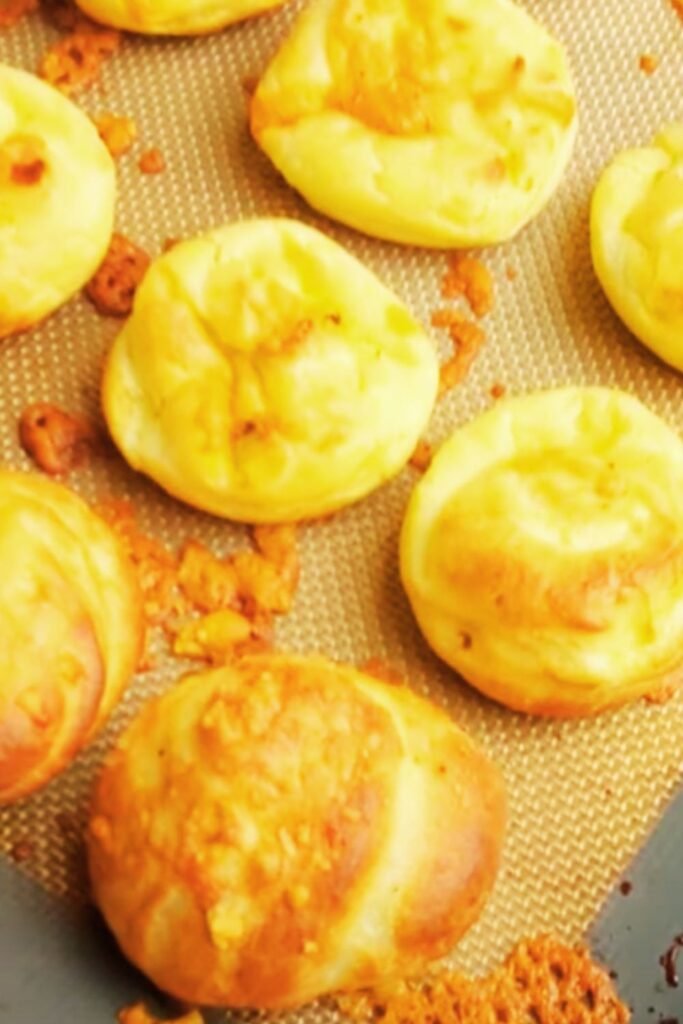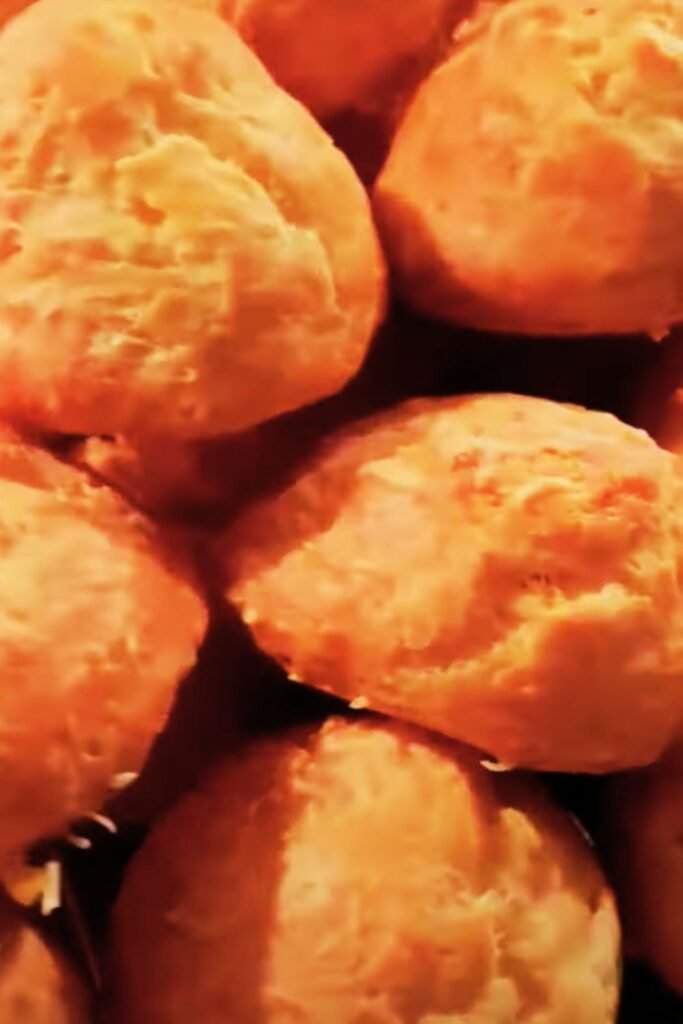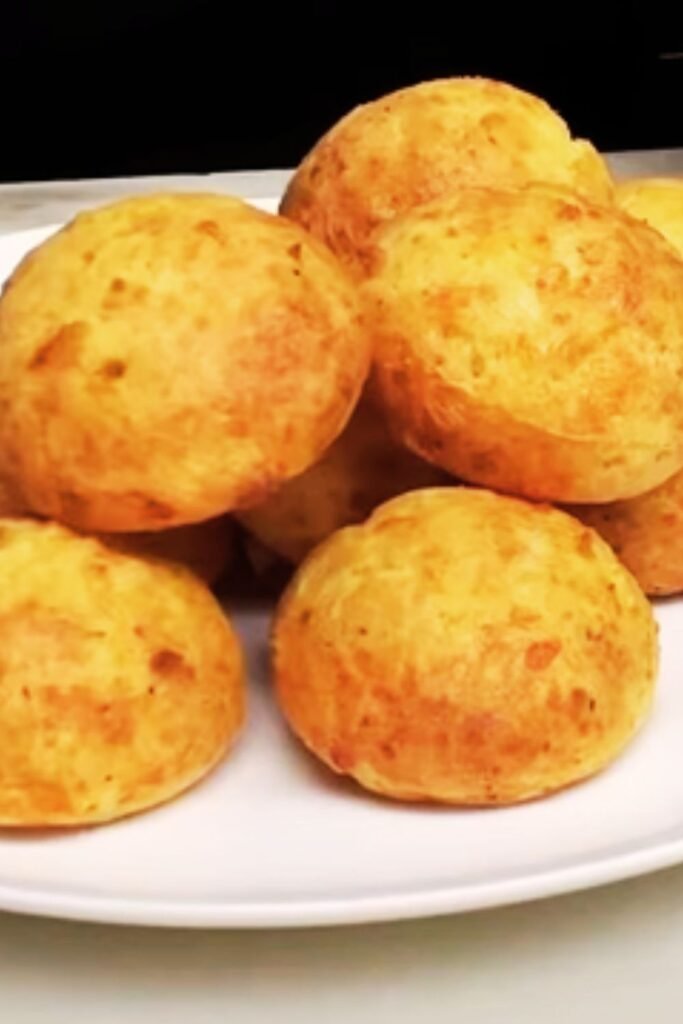When I first encountered gougères at a charming bistro in Lyon, I knew my culinary world had shifted forever. These ethereal, cheese-laden puffs practically floated off the plate, their golden exteriors giving way to impossibly light, airy interiors bursting with rich, savory flavor. Today, I’m sharing my perfected recipe for these French masterpieces, enhanced with not one, but two magnificent cheeses that will transform your kitchen into a Parisian patisserie.
Gougères represent the pinnacle of French choux pastry artistry. Unlike their sweet cousins éclairs and profiteroles, these savory delights showcase the magical transformation that occurs when eggs, butter, flour, and cheese unite in perfect harmony. My version elevates the traditional recipe by incorporating two complementary cheeses, creating layers of flavor that dance across your palate with each heavenly bite.
Understanding the Magic Behind Gougères
Choux Pastry: The foundation of gougères, this unique dough relies on steam for leavening, creating hollow centers perfect for trapping cheese-infused air pockets.
Pâte à Choux: The French term for choux pastry, literally meaning “cabbage paste” due to the resembling appearance of the baked puffs.
Gruyère Cheese: A Swiss alpine cheese with nutty, complex flavors that intensify when heated, making it ideal for baking.
Parmigiano-Reggiano: The “King of Cheeses,” providing sharp, crystalline notes that complement Gruyère’s creaminess.
Steam Leavening: The technique that makes choux pastry rise through moisture evaporation rather than chemical leaveners.
The beauty of gougères lies in their versatility and the science behind their creation. When water and butter reach a rolling boil, flour gets incorporated rapidly, cooking partially and forming a paste. This process, called “panade,” creates the foundation for incorporating eggs one by one, developing the proper consistency for piping and baking.

Essential Ingredients for Perfect Two-Cheese Gougères
| Ingredient | Measurement | Purpose | Quality Tips |
|---|---|---|---|
| Water | 1 cup | Creates steam for rising | Use filtered water for best flavor |
| Unsalted Butter | 8 tablespoons | Provides richness and structure | European-style butter preferred |
| Salt | 1 teaspoon | Enhances flavor profile | Fine sea salt works best |
| All-Purpose Flour | 1 cup | Forms pastry structure | Sift for smoothest texture |
| Large Eggs | 4-5 eggs | Creates lift and binding | Room temperature essential |
| Gruyère Cheese | 1 cup, grated | Primary cheese flavor | Aged 6-12 months ideal |
| Parmigiano-Reggiano | ½ cup, finely grated | Secondary flavor depth | 24-month aged minimum |
| Black Pepper | ¼ teaspoon | Subtle spice complement | Freshly ground only |
| Nutmeg | Pinch | Traditional French touch | Freshly grated preferred |
Detailed Preparation Method
My technique for creating flawless gougères has been refined through countless batches, incorporating professional pastry techniques I’ve learned from French chefs throughout my culinary journey.
Step 1: Preparing Your Kitchen Environment
Begin by preheating your oven to 425°F (220°C). Position racks in the upper and lower thirds of your oven, ensuring adequate space for the gougères to puff magnificently. Line two large baking sheets with parchment paper or silicone baking mats.
Prepare your mise en place meticulously. Grate both cheeses separately using the fine holes of a box grater. Room temperature eggs are crucial for proper incorporation, so remove them from refrigeration at least 30 minutes before beginning.
Step 2: Creating the Choux Base
In a heavy-bottomed saucepan, combine water, butter, and salt. Bring this mixture to a vigorous boil over medium-high heat, ensuring the butter melts completely before the water begins bubbling. The moment you achieve a rolling boil, remove the pan from heat immediately.
Add the sifted flour all at once, stirring vigorously with a wooden spoon. Return the pan to medium heat, stirring constantly for 60-90 seconds until the mixture forms a cohesive ball and pulls away from the sides of the pan. This process cooks the flour partially, creating the proper foundation for egg incorporation.
Step 3: Tempering and Egg Integration
Transfer the hot paste to the bowl of a stand mixer fitted with a paddle attachment. Allow it to cool for 2-3 minutes, stirring occasionally to release steam. This temperature reduction prevents the eggs from scrambling when added.

Begin adding eggs one at a time, beating thoroughly after each addition. The mixture will initially appear broken and curdled—this is perfectly normal. Continue beating until smooth before adding the next egg. After four eggs, assess the consistency by lifting the paddle; the dough should fall in a thick, V-shaped ribbon.
Step 4: Cheese Integration and Seasoning
With the mixer on low speed, gradually incorporate the grated Gruyère, followed by the Parmigiano-Reggiano. Add freshly ground black pepper and a generous pinch of nutmeg. The final mixture should be glossy, smooth, and hold its shape when piped.
Advanced Piping and Baking Techniques
Transfer the choux mixture to a large pastry bag fitted with a ½-inch round tip. Alternatively, use a large zip-lock bag with one corner snipped off. Pipe 1½-inch mounds onto prepared baking sheets, spacing them 2 inches apart to accommodate expansion.
For professional-looking gougères, use a damp finger to gently smooth any pointed peaks on top of each mound. This ensures even browning and attractive presentation.
Baking Process Breakdown
| Baking Stage | Temperature | Duration | Key Indicators |
|---|---|---|---|
| Initial Rise | 425°F (220°C) | 15 minutes | Puffed and set |
| Golden Brown | 375°F (190°C) | 12-15 minutes | Deep golden color |
| Crisp Finish | 350°F (175°C) | 5-8 minutes | Firm to touch |
| Cooling | Oven off, door cracked | 10 minutes | Prevents collapse |
The critical aspect of baking gougères involves managing oven temperature to achieve maximum puff while ensuring thorough cooking. Never open the oven door during the first 20 minutes, as this temperature drop can cause catastrophic collapse.

Flavor Variations and Creative Adaptations
Throughout my years of perfecting this recipe, I’ve discovered numerous variations that showcase the versatility of the basic gougère formula.
Herb-Infused Variations
- Thyme and Rosemary: Add 1 tablespoon fresh chopped herbs with the cheese
- Chive and Dill: Incorporate 2 tablespoons fresh herbs for spring freshness
- Sage and Brown Butter: Brown the butter before adding water for nutty depth
Alternative Cheese Combinations
- Comté and Roquefort: French alpine meets bold blue cheese intensity
- Aged Cheddar and Pecorino: Sharp English meets Italian sheep’s milk complexity
- Smoked Gouda and Manchego: Smoky Dutch paired with Spanish nuttiness
Spice and Seasoning Enhancements
- Paprika Gougères: Add 1 teaspoon smoked paprika for earthy warmth
- Cayenne Heat: Incorporate ¼ teaspoon cayenne for subtle fire
- Everything Bagel: Roll finished gougères in everything bagel seasoning
Serving Suggestions and Presentation Ideas
Gougères shine as versatile entertaining pieces, equally at home in casual gatherings or elegant soirées. I prefer serving them warm, about 10-15 minutes after removing from the oven, when their exteriors maintain crispness while interiors remain tender.
For cocktail parties, arrange gougères on tiered serving stands alongside complementary accompaniments like cornichons, grainy mustard, and thin slices of prosciutto. Their rich, cheesy flavor pairs beautifully with crisp champagne or sparkling water with citrus.
During brunches, I love presenting gougères as sophisticated alternatives to traditional pastries. They complement fresh fruit, artisanal jams, and premium coffee selections perfectly.
Storage and Reheating Guidelines
| Storage Method | Duration | Quality Retention | Reheating Instructions |
|---|---|---|---|
| Room Temperature | 24 hours | Excellent | 5 minutes at 350°F |
| Refrigerated | 3-4 days | Good | 8 minutes at 325°F |
| Frozen (baked) | 1 month | Fair | 12 minutes at 300°F |
| Frozen (unbaked) | 2 months | Excellent | Bake directly from frozen |
I often prepare gougères ahead for entertaining by freezing the piped, unbaked portions on parchment-lined trays. Once solid, transfer them to freezer bags and bake directly from frozen, adding 5-8 additional minutes to the initial high-temperature phase.
Troubleshooting Common Challenges
Over years of teaching this recipe, I’ve encountered virtually every possible mishap. Here are solutions to the most frequent issues:
Flat, Dense Gougères: Usually indicates insufficient egg incorporation or opening the oven door too early. Ensure each egg is fully integrated before adding the next, and resist the temptation to peek during initial baking.
Cracked Surfaces: Often results from oven temperature being too high initially. Start at 425°F as directed, but if your oven runs hot, reduce to 400°F for the first phase.
Soggy Interiors: Inadequate baking time typically causes this problem. Gougères should sound hollow when tapped and feel firm to the touch before removing from the oven.
Cheese Clumping: Occurs when cheese isn’t properly grated or when the choux base is too hot during incorporation. Use finely grated cheese and ensure the mixture has cooled adequately.
Nutritional Considerations and Dietary Adaptations
While traditional gougères aren’t suitable for most restrictive diets, I’ve successfully created modified versions for various dietary needs.
Gluten-Free Adaptation
Substitute almond flour combined with tapioca starch (¾ cup almond flour + ¼ cup tapioca starch) for wheat flour. The texture differs slightly but remains delicious.
Reduced-Fat Version
Replace half the butter with Greek yogurt and use part-skim versions of both cheeses. While not as rich, they maintain much of the original appeal.
Protein Enhancement
Add 2 tablespoons of unflavored protein powder with the flour for additional protein content without significantly altering taste.
Cultural Context and Historical Background
Gougères originated in Burgundy, France, where they traditionally accompanied local wines during tastings. The combination of rich, eggy pastry and aged cheeses provided perfect counterpoints to robust red wines, cleansing the palate between tastings.
French families often prepare gougères for special occasions, particularly during holidays and celebrations. The technique represents a rite of passage for aspiring home cooks, as mastering choux pastry requires understanding timing, temperature, and texture in ways that separate novice from experienced bakers.
My own journey with gougères began during a cooking class in Dijon, where a stern but kindly instructor taught me that patience and attention to detail matter more than fancy equipment or expensive ingredients. This philosophy continues to guide my approach to these delicate pastries.
Professional Tips for Consistent Success
After preparing thousands of gougères over the years, I’ve developed specific techniques that guarantee consistent results regardless of kitchen conditions or experience level.
Temperature Control: Invest in an oven thermometer to verify accurate temperatures. Most home ovens vary significantly from their settings, and precision matters enormously for choux pastry success.
Humidity Considerations: On particularly humid days, add an extra tablespoon of flour to compensate for moisture in the air. Conversely, in very dry conditions, you might need slightly less flour.
Egg Quality Assessment: Always crack eggs individually into small bowls before adding to the mixture. This prevents disasters from bad eggs and allows you to gauge exact amounts needed.
Timing Optimization: Prepare all ingredients and equipment before beginning. Choux pastry waits for no one, and having everything ready ensures smooth execution.
Advanced Techniques for Pastry Perfection
For those seeking to elevate their gougère game beyond the basics, consider these professional refinements I’ve developed through extensive experimentation.
Double-Baking Method
After initial baking, turn off the oven and prop the door slightly open, allowing gougères to dry gradually for 10-15 minutes. This technique ensures maximum crispness and prevents sogginess.
Steam Injection
Place a small oven-safe dish filled with boiling water on the oven floor during the first 10 minutes of baking. This creates additional steam, promoting maximum rise and golden coloring.
Cheese Crust Enhancement
Brush gougères lightly with beaten egg and sprinkle with additional grated cheese before baking for extra-rich surfaces and enhanced visual appeal.
Q&A Section
Q: Can I make gougères without a stand mixer? A: Absolutely! While a stand mixer makes the process easier, you can incorporate eggs by hand using a wooden spoon and plenty of elbow grease. The key is adding eggs gradually and beating vigorously until smooth after each addition.
Q: Why do my gougères collapse after cooling? A: This typically happens when they’re underbaked or when the oven door opens too early in the process. Ensure gougères are deeply golden and feel firm before removing, and never open the oven during the first 20 minutes of baking.
Q: Can I substitute different cheeses in this recipe? A: Yes, but choose cheeses that melt well and have good flavor when heated. Hard, aged cheeses work best. Avoid fresh cheeses like mozzarella or ricotta, as they contain too much moisture.
Q: How far ahead can I prepare gougères for a party? A: You can pipe and freeze unbaked gougères up to two months in advance, then bake directly from frozen. For same-day serving, bake them up to 4 hours ahead and reheat briefly before serving.
Q: What’s the secret to getting gougères to puff properly? A: The key factors are: proper choux consistency (should fall in ribbons from the spoon), adequate egg incorporation, correct oven temperature, and never opening the oven door during initial rising. Steam is essential for the puff!
Q: Can I make mini gougères for canapés? A: Definitely! Pipe smaller portions (about ¾-inch diameter) and reduce baking time to 18-22 minutes total, following the same temperature progression. They’re perfect for elegant appetizer presentations.
Q: Why is my choux pastry too thick or too thin? A: Consistency depends on proper flour incorporation and egg addition. If too thick, add another egg gradually. If too thin, you may have added eggs too quickly or your initial paste wasn’t cooked sufficiently.
Q: Can I add other ingredients like herbs or spices? A: Absolutely! Add dry herbs and spices with the cheese, but use restraint—typically 1-2 teaspoons maximum to avoid overwhelming the delicate cheese flavors. Fresh herbs should be finely chopped and patted dry.
Q: What’s the best way to reheat leftover gougères? A: Place them on a baking sheet and warm in a 350°F oven for 5-8 minutes until crispy outside and warm throughout. Avoid microwaving, which makes them soggy and chewy.
Q: Can I make gougères dairy-free? A: Traditional gougères rely heavily on butter and cheese for their characteristic flavor and texture. While you can experiment with vegan butter and nutritional yeast, the result will be quite different from the classic version.
These golden, cheese-laden puffs represent everything I love about French pastry: technique married with simplicity, tradition enhanced by personal touches, and the pure joy of sharing exceptional food with people you care about. Master this recipe, and you’ll have a showstopping addition to your culinary repertoire that never fails to impress and delight.